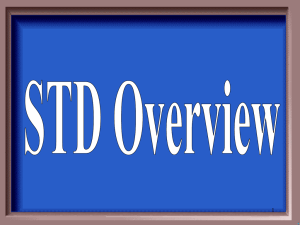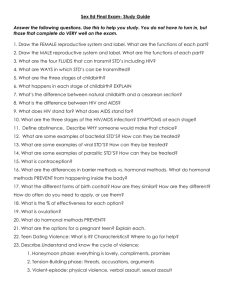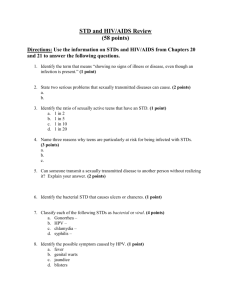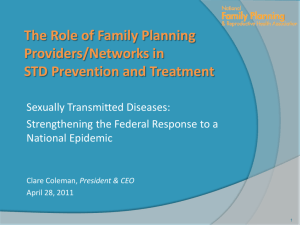Introductions - PAETC | Pacific AIDS Education and Training Center
advertisement
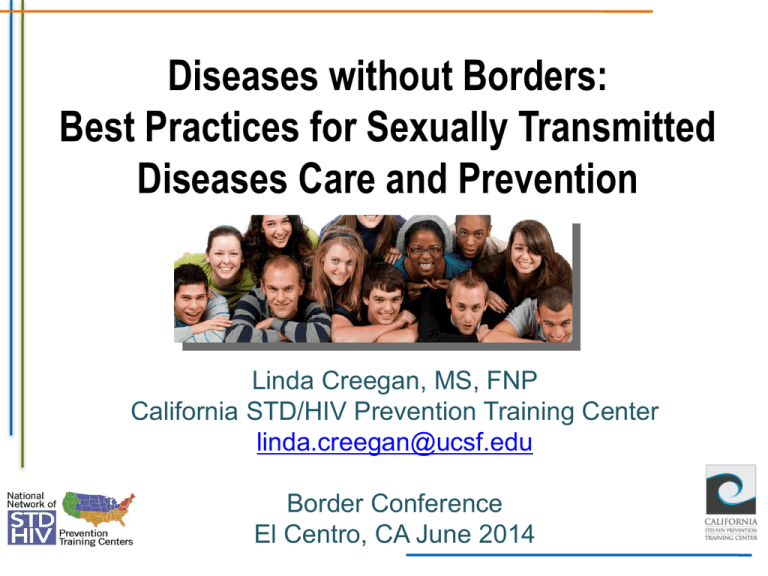
Diseases without Borders: Best Practices for Sexually Transmitted Diseases Care and Prevention Linda Creegan, MS, FNP California STD/HIV Prevention Training Center linda.creegan@ucsf.edu Border Conference El Centro, CA June 2014 I do not have any financial arrangements or affiliations with commercial sponsors which have direct interest in the subject matter: SEXUALLY TRANSMITTED DISEASES • Chlamydia • Chancroid • Gonorrhea • Trichomonas • Genital herpes • Syphilis • Granuloma • HIV / AIDS inguinale • HPV • Lice • Scabies • Hepatitis B • LGV • Hepatitis C • M. genitalium • Others….. • BV? Complications of STDs Infertility PID Infection Chlamydia Gonorrhea HPV Hepatitis B Trichomona s o HSV o Syphilis o o o o o Cancer HIV Perinatal Brain/organ damage Ectopic pregnancy Chronic pain Congenital infection Low birth weight Stillbirth CA STD Data and Statistics Priority Populations • Teens & young people • Pregnant women • Gay/Bi men (MSM) • People of color Testing in STD Care Testing applications • Case finding – Asymptomatic (screening) – Symptomatic (diagnostic) • Follow-up • Guide treatment (HIV resistance testing) • Surveillance Types of tests • Culture (susceptibility testing) • Serologic tests (antibodies in the blood) • Molecular-based tests (NAAT) • Combo tests – CT/GC – HIV/syphilis – Non-treponemal and treponemal Testing Approaches • In clinic – Clinician-collected – Self-collected • Outside the clinic – Collected at lab – Field-based program – Home testing Provide Those Free Sexual Health Services! • Essential Health Benefits related to STD/HIV prevention and care • Must be included in all health plans at no cost-sharing to patient – – – – – – Annual Wellness visit STD and HIV screening STD and HIV care HPV and Hep B Immunizations Risk Reduction counseling Pap smears 1. Ask three essential sexual history questions WHO are your partners? WHAT are your sexual and drug use practices? HOW do you try to prevent STDs/HIV? Risk assessment important since many STDs are asymptomatic 2. Screen for Chlamydia and Gonorrhea ALL sexually active adolescent and young women ≤ 25 years Pregnant women Men who have sex with men (MSM) Persons living with HIV Others according to risk CDC 2010 STD Tx Guidelines. www.cdc.gov/std/treatment Why screen? • • • • • Highly prevalent Frequently asymptomatic Reduces transmission Prevents complications HEDIS measure: chlamydia screening in females under 25 years old • Standard of care Sexually Active adolescents & up to age 25 Routine chlamydia and gonorrhea screening Others STDs and HIV based on risk Women over 25 years of age STD/HIV testing based on risk Pregnant women Chlamydia Gonorrhea (<25 years of age or risk) HIV Syphilis serology HepB sAg Hep C (if high risk) CDC 2010 STD Tx Guidelines www.cdc.gov/std/treatment Estimated Chlamydia Screening Coverage (HEDIS), Females Age 15–24, USA and California, 1999–2010 100 1999 2004 2010 90 Percent Screened 80 70 60 50 40 30 20 10 0 Natl MCO Natl Medicaid National MediCal MC Cal HMO FPACT California Source: National Committee on Quality Assurance; California DHCS Division of Medi-Cal Managed Care; Kaiser Permanente Northern CA; California DPH Office of Family Planning Rev. 4/2012 Who is falling through the cracks? Visits that do not require an exam Pregnancy test only Emergency contraception Contraception method follow-up • Refills • Depo-provera injection A pelvic exams is not necessary to obtain a chlamydia test Nucleic acid amplification tests (NAATs) u Highest sensitivity • Noninvasive samples – Urine – Self-collected vaginal swabs Major conclusions NAATs recommended for detection of genital tract infections in men and women – with and without symptoms Optimal specimen types are: First catch urine for men Self collected vaginal swabs from women NAATs recommended for: detection of rectal and oropharyngeal infections What about Women over age 25? CT Test Volume & Prevalence among Females by Age Test Volume % CT Pos 7 50% Test Volume 45000 6 40000 35000 5 30000 4 25000 20000 3 15000 2 10000 1 5000 0 0 10-14 15-19 20-24 25-29 30-39 40+ AGE (YEARS) CA FPACT Data, 2006 *Quest Diagnostics/Unilab: West Hills/Tarzana, Sacramento, San Jose CHLAMYDIA PREVALENCE CHLAMYDIA TEST VOLUME 50000 Which women over age 25 should be screened? Based on risk: – – – – Infection with CT or GC in past 2 years > 1 sex partner in past 12 months New partner in past 3 months Belief that a partner in the past 12 months may have had other sex partners at the same time Other indications: – Pregnancy – Contact to STD – New STD diagnosis CA CT Screening Guidelines Draft; Howard et al. Over 20. In prep. STI Screening Recommendations: HIV-positive Men & Women STI Chlamydia Gonorrhea Anatomic Site Genital, rectal if exposed Genital, rectal & oral if exposed Syphilis Trichomoniasis HSV-2 Serology Women only Serology Hep B sAg Hep C Serology Serology * Screen at least annually; repeat screening every 3-6 months as indicated by risk. MSM- Consider anal Pap screening Women-Cervical Pap screening; Consider anal Pap if hx of dysplasia. Primary Care Guidelines for the Management of Persons Infected with HIV: 2009 Update by the HIVMA of the IDSA. Clin Infect Dis 2009;49, 651-681. * STD Screening for MSM • • • • • • • • HIV Syphilis Urethral GC and CT Rectal GC and CT (if RAI) Pharyngeal GC (if oral sex) HSV-2 serology (consider) Hepatitis B (HBsAg) Anal Pap (consider for HIV+) * * At least annually, more frequent (3-6 months) if at high risk (multiple/anonymous partners, drug use, high risk partners) CDC 2010 STD Tx Guidelines www.cdc.gov/std/treatment Majority of Rectal Infections in MSM are Asymptomatic Rectal Infections 86% 84% Chlamydia Gonorrhea n=316 n=264 Asymptomatic Symptomatic 10% Urethral Infections 42% Chlamydia n=315 Gonorrhea n=364 Kent, CK et al, Clin Infect Dis July 2005 Proportion of CT and GC infections MISSED among 3398 asymptomatic MSM if screening only urine/urethral sites, San Francisco, 2008-2009 Chlamydia Gonorrhea Marcus et al, STD Oct 2011; 38: 922-4 Chlamydia and Gonorrhea NAA Testing • …not FDA-cleared for rectal or pharyngeal specimens but now the preferred testing method over culture • Validation procedures can be done by labs to allow use of a non-FDA-cleared test or application • Quest & LabCorp currently provide GC/CT NAAT for rectal/pharyngeal specimens NAAT Laboratory Ordering and Billing Codes Company-Specific Ordering Codes for Combined GC/CT Nucleic Acid Amplified Tests (NAATs) Company-Specific Ordering Codes for CT test only LabCorp* Quest* LabCorp Rectal 188672 16506 188706 Pharyngeal 188698 70051 188714 NAATs are offered at (or from) any location in the country with these two codes. For information on specimen collection and transportation, clinicians should contact the local reference laboratory representative. CPT Billing Codes CT detection by NAAT 87491 GC detection by NAAT 87591 *CDC does not endorse these laboratories, however, they represent the largest laboratories nationally. There may be other private laboratories that have verified rectal and pharyngeal testing with NAATs. Many PHLs have also verified rectal and pharyngeal testing. Bolan, CDC webinar March 2011 Case Scenario • • • • 22 year old female Asymptomatic, no prior STDs STD Screening done on intake No known drug allergies • GC positive • CT negative What regimen would you use to treat Gonorrhea? A. Ceftriaxone 250 mg IM B. Azithromycin 2 gm PO C. Ceftriaxone 250 mg IM plus azithromycin 1 gm PO D. Ceftriaxone 125 mg IM plus azithromycin 1gm PO 59% 18% 18% p. .. M gI xo ne 12 5 m Ce ftr ia xo ne 25 0 yc in Ce ftr ia m gI M gm 2 m 25 0 Az ith ro m on e ax Ce ftr i p. .. PO gI M 5% Development of GC Resistance 1945: Penicillin first used widely for TX 1976: Pen-R NG first identified in US (in CA) 1930s-1970s 1936: Sulfanilamides introduced as TX 2001: First cephalosporin TX failures in Japan 1980s 1986: GISP started by CDC 1990s 2002: Fluoroquinolones no longer recommended for TX by CA 2000s 1991: QRNG first identified in US (in HI) 1989: Penicillin no longer recommended for TX by CDC 2010s 2010: Dual TX recommended for TX by CDC 2007: Fluoroquinolones no longer recommended for TX by CDC Who is most likely to be affected by cephalosporin-resistant GC? Men who have sex with men California 30 3. Use Current Treatment for Gonorrhea Gonorrhea Treatment: Uncomplicated Genital/Rectal/Pharyngeal Infections Ceftriaxone 250 mg IM in a single dose PLUS* Azithromycin 1 g orally ** or Doxycycline 100 mg BID x 7 days * Regardless of CT test result MMWR Weekly August 10, 2012 MMWR updates CDC 2010 Guidelines **Azithromycin preferred as 2nd antimicrobial Do you have ceftriaxone and azithromycin available onsite? 78% No 22% Ye s 1. Yes 2. No Gonorrhea Treatment Alternatives Anogenital Infections ALTERNATIVE CEPHALOSPORINS: Cefixime 400 mg orally once PLUS Dual treatment with azithromycin 1 g (preferred) or doxycycline 100 mg BID x 7 days, regardless of CT test result IN CASE OF SEVERE ALLERGY: Azithromycin 2 g orally once (Caution: GI intolerance, emerging resistance) Proposed in case of allergy: gentamicin 240 mg IM + azithromycin 2g orally or gemifloxacin 320 mg orally + azithromycin 2g orally MMWR 2012 / 61(31);590-594 Test of Cure • Current TOC recommendation: Test of cure in 1 week for anyone treated w/ alternative regimens – Routine TOC poses implementation challenges – No data on TOC positivity rates in absence of symptoms • Proposed: Limit TOC only to pharyngeal GC treated with alternative regimen, may extend interval to 14 days How to slow the spread of A-R Gonorrhea • New antibiotics • Multiple antibiotics • Surveillance – Rapid response plans – Resistance testing of isolates Suspected GC Treatment Failure What should I do? CDPH Recommendations CULTURE: if GC culture not available on-site, call CA STD Control Branch for resources 510 620 3400 REPEAT TREATMENT: Ceftriaxone 500 mg IM PLUS Azithromycin 2 g orally in a single dose* REPORT: To your local health department within 24 hours; call STD Control Branch if consult desired TREAT PARTNERS: All partners in last 60 days should be treated with CTX 500 mg + AZ 2g TEST OF CURE (TOC): Patient returns in 1 week for TOC with culture (if culture not avail, with NAAT) * If reinfection suspected instead of treatment failure, OK to repeat treatment with CTX 250 + AZ 1g 4. Ensure Partner Management Patient referral • Ask patient to notify partner and ensure treatment • Suggest patient bring partner to clinic for concurrent treatment (“BYOP”) • Internet-based anonymous notification Expedited partner treatment (EPT) • Patient-delivered partner treatment (PDPT) • Health department field-delivered treatment • Pharmacy-based Provider or clinic-based referral Health department referral Legal Status of EPT in the U.S. PERMISSIBLE 32 states UNCERTAIN 11 states PROHIBITED 7 states CDC EPT Legal Status Updated August 2012 www.cdc.gov/std/ept Online Partner Referral Patients use website to notify partners - anonymous - free - referrals for testing inspot.org sotheycanknow.org Nadine 28 y/o non-pregnant female treated for CT. When should you schedule her follow-up? 46% 19% 15% 15% e su r No t he r.. . ye ar 1 th s on m 3 fo r fo ra ... ... a fo r ee ks w 3 w ee k fo ra T. .. 4% 1 A. 1 week for a TOC B. 3 weeks for a TOC C. 3 months for a test for reinfection D. 1 year for her annual exam E. Not sure 5. Retest for CT and GC at three months following treatment Retesting Recommendations: Retest all women and men with CT or GC 3 months after treatment* “Opportunistic” testing Retest whenever possible, 1-12 mo *CDC 2010 STD Tx Guidelines, www.cdc.gov/std/treatment Repeat Chlamydial Infection is Common Reinfection (%) 40 Retesting Prevalence 30 20 Typical Screening Prevalence 10 0 0 2 4 6 8 10 12 Months Follow-up Hosenfeld C, et al. Sex Transm Dis. 2009 Aug;36(8):478-89 Repeat Infection is Dangerous • Repeat CT infection 6 leads to higher risk 5 of complications: pregnancy, infertility • Most infections are Ectopic Pregnancy 4 Relative Risk PID, ectopic Pelvic Inflammatory Disease 3 2 1 asymptomatic 0 1st 2nd 3rd Infection Infection Infection Hillis SD, et al. (1997). Am J Obstet Gynecol 176(1 Pt 1): 103-7. Chlamydia Care Continuum: Family PACT females age ≤25 years (N=686,327) Total Est Cases Cases detected 78% Cases treated 92% Pt returns 1-6 mo. retested 60% 59% Pos at Restest Source: Family PACT Annual Report FY 11-12 http://www.familypact.org/Research/reports/FamPactAnnualReport2011-12_ADA.pdf Getting clients back in for retesting: • Counseling at treatment visit • Written materials • Advance appointments • Traditional reminder systems (telephone and postcards) • Text message and/or email reminders Downer SR et al Aust Health Rev 2006;30:389; Leong KC et al. Fam Pract 2006; 23:699. Appointment and STI Retest Reminders For more information: providers@bedsider.org 6. Recommend the HPV Vaccine Population ACIP Recommendation Gender Age Females 11-12 (as young as 9) Males Routine vaccination with either HPV4 or HPV2 13-26 Routine catch-up vaccination either HPV4 or HPV2* 11-12 Routine vaccination w HPV4 (as young as 9) MSM & HIV+ Males 13-21 Routine catch-up vaccination HPV4 22-26 Permissive recommendation HPV 4 22-26 Routine catch-up vaccination HPV 4 * Irrespective of history of abnormal Pap, HPV, genital warts MMWR, May 28 2010; 59(20):626-629 , 630-632 MMWR , December 23 2011; 60(50);1705-1708 The HPV Family Dermal HPVs Common skin warts (~60 types) “Low-risk” Wart types Mucosal HPVs (~40 types) “High-risk” Cancer types Incidence of Cervical HPV Detection in Women from the Time of Sexual Debut 70% 60% Cervical HPV Detection 50% 40% 30% 20% 10% 0% 0 6 12 18 24 30 36 42 48 Time since first intercourse (months) Collins et al. Br J Obstet Gynecol 2002;109:96 Clearance of HPV Infections Over 2 Years Percent HPV Infected 100 80 60 40 20 0 0 3 6 9 12 15 18 21 24 Time from HPV infection (months) Adapted from Brown et al. JID 2005:191;182 Low Risk Mucosal HPVs TYPES • Most common: 6, 11 • Others: 40, 42, 43, 44, 54, etc DISEASES • Genital and oral warts • Respiratory papillomatosis • Low grade cervical Pap abnormalities Anogenital Warts Source: DOIA Website, 2000 HPV Vaccine Efficacy in Preventing Precancer and Warts FEMALES MALES HPV Disease CIN 2+ Genital Warts VIN/VaIN 2+ HPV 4 98% 100% 100% HPV 2 98% ----- Genital warts AIN 90% 78% ----- CIN = Cervical Intraepithelial Neoplasia VIN = Vulvar Intraepithelial Neoplasia AIN = Anal Intraepithelial Neoplasia VaIN = Vaginal Intraepithelial Neoplasia Future II Study Group. N Engl J Med 2007;356(19):1915-27 Garland SM et al. NEJM 2007;356(19):1928-43 Paavonen et al. Lancet. 2009;374(9686):301-14 Giuliano et al. NEJM 2011; 364:401-11 Palefsky et al. NEJM 2011; 365:1576-85. ACIP Recommendations: Administration, Precautions and Contraindications • Synchronized dosing: 3-dose schedule, second dose at 1-2 months after first dose, third dose 6 months after first dose • Minimum intervals: – Minimum time b/w 1st & 2nd = 4 wks – Minimum time b/w 2nd & 3rd = 12 wks – Minimum time b/w 1st & 3rd = 24 wks • If schedule is interrupted, the series does not need to be restarted • HPV vaccines can be given simultaneously/before/after other vaccines • If possible, the same product should be used for all doses in the series • No change in cervical cancer screening recommendations MMWR, May 28, 2010; 59(20):626-629, 630-632 ACIP Recommendations: Administration, Precautions and Contraindications • Pregnancy: HPV vaccines are not recommended for use in pregnant women; however pregnancy testing is not needed before vaccination. Any exposure to vaccine during pregnancy should be reported to the appropriate vaccine pregnancy registry: Pregnancy Registry: 800-986-8999 (Merck) or 888452-9622 (GSK vaccine) • Contraindications: allergy to vaccine component, severe illness • Quadrivalent HPV vaccine contains yeast antigens • Bivalent HPV vaccine in prefilled syringes contraindicated for persons with anaphylactic latex allergy Adverse reactions should be reported to VAERS: www.vaers.hhs.gov or 800-822-7967 MMWR, May 28, 2010; 59(20):626-629, 630-632 Vaccine Funding Programs Vaccines for Children Program • Up to age 18, Medicaid eligible, uninsured or underinsured • Receiving immunizations through a Federally Qualified Health Center or Rural Health Clinic, or • Native American or Alaska Native Merck Vaccine Assistance Program • Age ≥ 19, low income, and no health insurance coverage • Phone number 1-800-293-3881 (8a-8p EST) • http://www.merck.com/merckhelps/vaccines/home.html Merck Dose Replacement Program • Vaccine doses provided but not reimbursed • https://www.drp4gardasil.com/Site/Home.aspx GSK Vaccines Access Program • Age 19-25, income eligible, and no heath insurance • www.gskforyou.com HPV Vaccine Uptake, Girls Ages 13-17 National Immunization Survey, 2007-2010 49% 44% 37% 25% MMWR 2008 / 57(40):1100-3; MMWR 2009 / 58(36):997-1001; MMWR 2010 / 59(32):1018-23; MMWR 2011 / 60(33):1117-1123 7. Offer Management for Recurrent/Persistent Vaginitis Challenges in Managing Vaginitis • Patient factors – Self-treatment may preclude diagnosis – Clients seek help from multiple providers • Provider factors – Under-utilization of available tests – Insensitive clinic-based tests – Dependent on provider skills Bacterial Vaginosis Decrease in lactobacilli Polymicrobial overgrowth Enzymes degrade the protective effects of cervical mucus and immune factors Photo: Seattle PTC Bev….. “I have BV again!” Recurrence rates as high as 30% at 3 months and 80% at 9 months Etiology unclear Resistance? Re-infection? Unrecognized trigger? Failure of lactobacilli to recolonize? Management Confirm diagnosis Condoms No douching Intermittent metronidazole gel (twice a week intravaginally) Recurrent BV: Success with Suppressive Treatment Recurrence Prophylactic phase (4 mo) MTNZ 13/51 (26%) Clinical Gram Stain 8/45 (18%) Placebo P value 26/44 (59%) <.001 14/35 (40%) .03 Observation phase (3 mo) Clinical 26/51 (51%) 33/44 (75%) .02 Gram Stain 17/45 (38%) 17/35 (49%) .33 Sobel JD et al, Am J ObGyn. May 2006 Candice……. Majority of women have no predisposing or underlying conditions Non-albicans more common Pathogenesis is unclear Deficient host response? Overactive host response? Relapse/reinfection? Photos; Mosby STD Atlas 1997 and Seattle STD/HIV PTC Initial Treatment Longer regimen of topical therapy (7-10 d) Fluconazole (100 mg, 150 mg, or 200 mg) p.o. every 3rd d x 3 Maintenance Regimens Fluconazole (100 mg, 150 mg, 200 mg) qw x 6 m OR if not feasible Topical antifungals used intermittently Trixie….. First treatment failure, re-treat with: Metronidazole 500 mg PO BID x 7 days If repeat failure, treat with: Metronidazole 2 g PO x 5 days Tinidazole 2 g PO x 5 days Susceptibility testing: send isolate to CDC CDC Consult & T. vaginalis susceptibility (404-718-4141) Diagnostic tests for Trichomonas Sekisui Diagnostics BioMed Diagnostics – CLIA-waived – Needs incubator – Results in 10 minutes Gen-Probe APTIMA – Read at 3 and 5 days – 83% sensitive compared Trichomonas vaginalis Assay to culture • Same specimen types as for • other APTIMA tests • Close to 100% sensitive; • Slightly less sensitive using urine • Over 99% specific Trich in HIV + Women • Screen on entry to care • Retest at 3 months after treatment • Consider metronidazole 500 mg p.o. bid x 7d instead of stat dose OH, NO!! She’s allergic to metronidazole! Treatment Options with “Azole” Allergy • Consult with specialist – Metronidazole desensitization • Helms et al, Am J Obstet Gynecol 2008 • Perlman et al, Am J Obstet Gynecol, 1996 • Kurohara et al, j Allergy Clin Immunol, 1991 • Paramomycin vaginal inserts – not as effective 8. Encourage Good Old Condoms! Openers for a Conversation about Condoms • Tell me about your experience with condoms. • Some men take condoms almost for granted, and other men really dislike them. What about you? • How willing have you found guys to be about using condoms? Making the Change Goal: to improve patient care by improving medical practice What can you do on your own? What can you realistically influence? What can you advocate for? THANK YOU!!!! Questions? A bit more info….. Online STD Resources CDC Treatment Guidelines www.cdc.gov/std/treatment California STD/HIV Prevention Training Center www.stdhivtraining.org California Department of Public Health STD Control Branch www.std.ca.gov California Laws and Regulations STD Reporting to Public Health • Which diseases? – – – – – – Syphilis within 1 day HIV/AIDS Chlamydia, including LGV Gonorrhea Chancroid Pelvic Inflammatory Disease (PID) Within 7 days • By whom? – Provider and Laboratory • To whom? The jurisdiction where patient resides • How? CMR to be completed by the provider Partner Management Provider Responsibility • The clinician should: – Attempt to determine the source of infection – Determine the intimate and sexual contacts of the infected patient – Make an effort with patient to bring in those contacts for exam and treatment • Persons determined as source of infection but not under treatment within 10 days of infection should be reported to the health officer • EPT is allowable for CT, GC, and trichomoniasis CCR Title 17 §2636 Minor’s Rights to STD Care in California • Minors age 12 and above are able to consent to STD and reproductive health care without parental permission • As of January 1, 2012, minors may also consent to medical care related to prevention of STD (e.g., HPV vaccine) • Minors have a right to confidentiality • Parents are not liable for costs of STD care • Reporting requirements for non-consensual (and “unlawful”) sexual activity CA Family Code §6926 Transmission of HSV-2 to Susceptible Partners is Reduced with Once-Daily Suppression • Monthly serum samples collected from susceptible partners • Valacyclovir group showed • decreased transmission • lower frequency of shedding • fewer copies of HSV-2 DNA when shedding occurred 4 Percent Transmission • 1484 heterosexual couples randomized to 500 mg of valacyclovir vs placebo once daily for 8 months 3.6% 3.5 3 2.5 2 1.9% 1.5 1 0.5 0 Valacyclovir Group Control Group (N=743) (N=741) Corey et al, NEJM 2004; 350(1):11-20. Gardasil or Cervarix: Which is better? • BOTH HPV Vaccines: • Effective in preventing 16/18-related cervical dysplasia • Good safety profile • High cost – Gardasil advantages: • Protects against 6/11-related genital warts • Licensed for males • Indications vulvar/vaginal dysplasia – Cervarix advantages: • Higher titer levels • May give greater cross-protection against other oncogenic HPV types • Effectiveness data for preventing persistent re-infection
